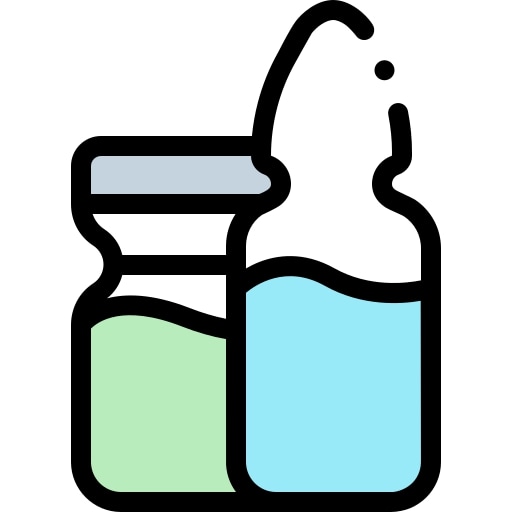INSULIN HUMAN, ISOPHANE (NPH) 100 UI/ml, 10ml, vial N
Valid Article
INSULIN, HUMAN, ISOPHANE (NPH)
Full Name
Insulatard®(DINJINSHI1VN)
Therapeutic Action
Pancreatic hormone, hypoglycaemic
Intermediate-acting isophane human insulin.
Isophane insulin is a mixture of regular human insulin and NPH (Neutral Protamine Hagedornis), which is used to delay absorption and prolong the duration of action.
Action profile:
- onset of action: 1 - 2 hours
- peak action: 4 - 12 hours
- duration of action: 14 - 18 hours
These action profiles are based on subcutaneous injections and are approximate. They depend on the dose injected, the type and brand of insulin and can vary significantly from one patient to another.
Indications
Insulin to cover basal insulin needs.
Instructions for use
Must be given as deep SC injection only.
Before using insulin for the first time, allow it to reach room temperature for 1 or 2 hours (cold insulin is more painful).
Preparation for administration
- Wash hands.
- Check the insulin vial (type and strength of insulin, expiry date) and inspect the solution (it should be opaque, white and aqueous).
- Use an insulin syringe with a fixed needle: 1 ml syringe graduated in 2 IU or 0.5 ml syringe graduated in 1 IU (for children).
- Stir the insulin by gently rolling the vial between the palms of the hands.
- Draw air into the syringe and inject it into the vial.
- Draw the required dose of insulin into the syringe.
How to administer SC insulin
- Insulin can be injected into the abdomen (two fingers away from the belly button), upper arm, buttocks, hips, buttocks, or the front or side of the thigh.
- Repeatedly injecting insulin in the same area can cause lumps, swelling and thickened skin, which may interfere with proper absorption of the insulin. See the picture below on “rotating” injection sites.
- Do not inject insulin into areas with wounds or bruising.
- Clean the chosen injection site with soap and water. Allow to dry.
- Pinch the skin.
- Hold the syringe like a pencil at a 90-degree angle to the skin and insert the needle with one quick motion.
- Inject the dose of insulin. Wait for 5 seconds before removing the needle from the skin.
- Apply gentle pressure on the injection site with a finger for 5-10 seconds to prevent insulin from leaking out.
- Do not recap the syringe. Dispose of the needle safely in a sharps container.
Precautions for Use
Mixing two types of insulin (rapid-acting and isophane) in the same syringe should only be done under strict medical prescription.
Switching the patient to a different insulin type or brand (manufacturer) is not recommended.
The manufacturer is identified by a letter at the end of the code and the label: N = Novo Nordisk, S = Sanofi, L = Lilly.
Caution! In order to simplify ordering and the medical list, the standard is the isophane insulin from Novo Nordisk (DINJINSHI1VN).
Storage
- Unopened vials: store in the refrigerator between 2°C and 8°C - Protect from sunlight
- Opened vials (in-use) Insulatard®: may be kept for up to 4 weeks at temperature not exceeding 25ºC.
- Do not freeze. Discard any vial that has been frozen.
- Keep the vial in its outer packaging.


![[KMEDMHWM12B] (mod ward) COLD CHAIN MEDICINES](/web/image/product.template/573297/image_256/%5BKMEDMHWM12B%5D%20%28mod%20ward%29%20COLD%20CHAIN%20MEDICINES?unique=9570d37)
![[KMEDMHWM21B] (mod ward) INJECTABLE MEDICINES, cold chain](/web/image/product.template/569013/image_256/%5BKMEDMHWM21B%5D%20%28mod%20ward%29%20INJECTABLE%20MEDICINES%2C%20cold%20chain?unique=a7a623e)
![[KMEDMHIM21B] (mod ICU) INJECTABLE MEDICINES, cold chain 2021](/web/image/product.template/574386/image_256/%5BKMEDMHIM21B%5D%20%28mod%20ICU%29%20INJECTABLE%20MEDICINES%2C%20cold%20chain%202021?unique=4195f0f)
![[KMEDMSUP05NB] (IEHK 2024 suppl. module) SUPPLEMENTARY NCD COLD CHAIN UNIT](/web/image/product.template/583186/image_256/%5BKMEDMSUP05NB%5D%20%28IEHK%202024%20suppl.%20module%29%20SUPPLEMENTARY%20NCD%20COLD%20CHAIN%20UNIT?unique=e07fede)
![[KMEDMHCM11B] (mod OPD) INJECTABLE MEDICINES, cold chain](/web/image/product.template/572692/image_256/%5BKMEDMHCM11B%5D%20%28mod%20OPD%29%20INJECTABLE%20MEDICINES%2C%20cold%20chain?unique=c393c74)
![[KMEDMSUP04NB] (supplementary unit 2018) MODULE NCD COLD CHAIN](/web/image/product.template/572572/image_256/%5BKMEDMSUP04NB%5D%20%28supplementary%20unit%202018%29%20MODULE%20NCD%20COLD%20CHAIN?unique=083ffe7)
![[KMEDMSUP04B] (supplementary unit 2018) MODULE MEDICINES COLD CHAIN](/web/image/product.template/572558/image_256/%5BKMEDMSUP04B%5D%20%28supplementary%20unit%202018%29%20MODULE%20MEDICINES%20COLD%20CHAIN?unique=86872e5)
![[DINJINSHI3APN] INSULIN HUMAN, ISOPHANE (NPH) 100 UI/ml, 3ml, pref. pen N](/web/image/product.template/583143/image_256/%5BDINJINSHI3APN%5D%20INSULIN%20HUMAN%2C%20ISOPHANE%20%28NPH%29%20100%20UI-ml%2C%203ml%2C%20pref.%20pen%20N?unique=fbef3a2)
![[L049COLM08E-P] Cold Chain Management Guideline 2025](/web/image/product.template/578683/image_256/%5BL049COLM08E-P%5D%20Cold%20Chain%20Management%20Guideline%202025?unique=3c853bb)
![[L049COLM08F-P] Chaîne du Froid, Guide de gestion](/web/image/product.template/589199/image_256/%5BL049COLM08F-P%5D%20Cha%C3%AEne%20du%20Froid%2C%20Guide%20de%20gestion?unique=47cb746)
![[L049COLM08S-P] Cadena de frio. Guia de gestion](/web/image/product.template/589198/image_256/%5BL049COLM08S-P%5D%20Cadena%20de%20frio.%20Guia%20de%20gestion?unique=47cb746)
![[SINSSYLIN02] SYRINGE, U-100 insulin, 1ml + fixed needle 6-8 mm](/web/image/product.template/569290/image_256/%5BSINSSYLIN02%5D%20SYRINGE%2C%C2%A0U-100%20insulin%2C%C2%A01ml%C2%A0%2B%C2%A0fixed%C2%A0needle%C2%A06-8%C2%A0mm?unique=9353864)
![[SINSSYLIN03] SYRINGE, U-100 insulin, 0.5ml + fixed needle 6-8 mm](/web/image/product.template/580969/image_256/%5BSINSSYLIN03%5D%20SYRINGE%2C%C2%A0U-100%20insulin%2C%C2%A00.5ml%C2%A0%2B%C2%A0fixed%C2%A0needle%C2%A06-8%20mm?unique=6b34de5)